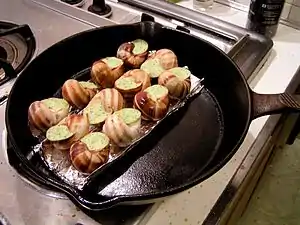Helix lucorum
Helix lucorum is a species of large, edible, air-breathing land snail, a terrestrial pulmonate gastropod mollusk in the family Helicidae, the typical snails. [2]
| Helix lucorum | |
|---|---|
 | |
| live specimen of Helix lucorum | |
| Scientific classification | |
| Kingdom: | Animalia |
| Phylum: | Mollusca |
| Class: | Gastropoda |
| Subclass: | Heterobranchia |
| Superorder: | Eupulmonata |
| Order: | Stylommatophora |
| Superfamily: | Helicoidea |
| Family: | Helicidae |
| Genus: | Helix |
| Species: | H. lucorum |
| Binomial name | |
| Helix lucorum | |
| Synonyms[1] | |
| |
Description

Adult snails weight about 20-25 g.[3]
The width of the shell is 35-60.[4] The height of the shell is 25–45 mm.[4]
This species of snail makes and uses love darts.
Distribution
The native distribution is Caucasus, Anatolia and, arguably, Balkans, it also invaded many other regions since ancient times.[5]
Few different lineages of Helix lucorum has a distinct different shell's coloration and in some regions the snails from the different lineages are invaded during the different periods forming the populations that differs from each other.[5]
Eastern native range with main genetic diversity of the species:
Balkans (probably native):
Other countries:
- Israel[7]
- Syria
- Russia - could be native in Caucasus, invasive in some other regions[5]
- Italy - probably invasive[5]
- Hungary - probably invasive[5]
- Romania - probably invasive[5]
- Ukraine - invasive, in Crimea ("Helix taurica Krynicki, 1833") at least since early 19 century, probably much longer, these populations originated from Anatolia;[5] other colonies of a different lineage also appear since 2000s in mainland part of Southern Ukraine and in Crimea as well[5][8][9]
- Czech Republic - invasive, since 2009, as of 2011 the only locality is Prague-Žižkov[4][10]
- Slovakia - invasive, since 2013, as of 2014 the only locality is in Bratislava[11]
- France - invasive
- Great Britain - invasive, since 2009, at Wimbledon[12]
Ecology
The diameter of the egg is 4.4 mm.[13] Juvenile snails that are two to three months old weigh 0.5-0.9 g.[3]
Human use
Helix lucorum is used in cuisine as escargots.
 Helix lucorum served as escargots | |
| Nutritional value per 100 g (3.5 oz) | |
|---|---|
| Energy | 95 kcal (400 kJ) |
0 g | |
| Sugars | 0 g |
| Dietary fiber | 0 g |
1.59 g | |
| Saturated | 0 g |
| Trans | 0 g |
19.05 g | |
| Vitamins | Quantity %DV† |
| Vitamin A equiv. | 0% 0 μg |
| Vitamin C | 0% 0 mg |
| Minerals | Quantity %DV† |
| Calcium | 16% 159 mg |
| Iron | 18% 2.29 mg |
| Sodium | 7% 103 mg |
| Other constituents | Quantity |
| Cholesterol | 206 mg |
| |
| †Percentages are roughly approximated using US recommendations for adults. | |
References
- http://www.fauna-eu.org/cdm_dataportal/taxon/24610e8f-4bba-40a1-a1c3-6d46ff884803#page-toc cited 3 December 2015
- MolluscaBase eds. (2020). MolluscaBase. Helix lucorum Linnaeus, 1758. Accessed through: World Register of Marine Species at: http://marinespecies.org/aphia.php?p=taxdetails&id=1050278 on 2020-05-02
- Danilova A.B. & Grinkevich L. N. (2012). "Failure of Long-Term Memory Formation in Juvenile Snails Is Determined by Acetylation Status of Histone H3 and Can Be Improved by NaB Treatment". PLoS ONE 7(7): e41828. doi:10.1371/journal.pone.0041828.
- (in Czech) Horsák M., Juřičková L., Beran L., Čejka T. & Dvořák L. (2010). "Komentovaný seznam měkkýšů zjištěných ve volné přírodě České a Slovenské republiky. [Annotated list of mollusc species recorded outdoors in the Czech and Slovak Republics]". Malacologica Bohemoslovaca, Suppl. 1: 1-37. PDF.
- Korábek O., Juřičková L., Balashov I., Petrusek A. The contribution of ancient and modern anthropogenic introductions to the colonization of Europe by the land snail Helix lucorum Linnaeus, 1758 (Helicidae) // Contributions to Zoology. — 2018. — 87 (2). — P. 61—74.
- Mumladze L. (2013). "Shell size differences in Helix lucorum Linnaeus, 1758 (Mollusca: Gastropoda) between natural and urban environments". Turkish Journal of Zoology 37: 1-6.
- Commonwealth of Australia (2002 April). "Citrus Imports from the Arab Republic of Egypt. A Review Under Existing Import Conditions for Citrus from Israel Archived 2009-01-09 at the Wayback Machine". Agriculture, Fisheries and Forestry, Australia. Caption: Gastropods, page 12 and Appendix 2.
- Balashov I. & Gural-Sverlova N. (2012). "An annotated checklist of the terrestrial molluscs of Ukraine". Journal of Conchology 41(1): 91-109.
- Balashov I.A., Kramarenko S.S., Zhukov A.V., Shklyaruk A.N., Baidashnikov A.A., Vasyliuk A.V. 2013. Contribution to the knowledge of terrestrial molluscs in southeastern Ukraine. Malacologica Bohemoslovaca. 12: 62–69.
- Peltanová A., Petrusek A., Kment P. & Juřičková L. (2011). "A fast snail's pace: colonization of Central Europe by Mediterranean gastropods". Biological Invasions 14(4): 759-764. doi:10.1007/s10530-011-0121-9.
- Čejka T. & Čačaný J. (2014). "The first record of the Turkish snail (Helix lucorum L., 1758) in the Slovak Republic". Malacologica Bohemoslovaca 13: 124–125. PDF.
- Palmer, P. (2010). "Helix lucorum in Wimbledon, S.W. London". Mollusc World. 23: 12.
- Heller J.: Life History Strategies. in Barker G. M. (ed.): The biology of terrestrial molluscs. CABI Publishing, Oxon, UK, 2001, ISBN 0-85199-318-4. 1-146, cited page: 428.
External links
| Wikimedia Commons has media related to Helix lucorum. |